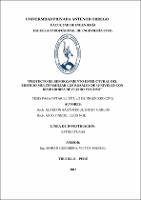| dc.contributor.advisor | Moran Guerrero, Victor Manuel | |
| dc.contributor.author | Alarcón Sagástegui, Jhosip Carlos | |
| dc.contributor.author | Asto Pinedo, Jesus Noe | |
| dc.creator | Alarcón Sagástegui, Jhosip Carlos | |
| dc.date.accessioned | 2018-07-09T21:01:16Z | |
| dc.date.available | 2018-07-09T21:01:16Z | |
| dc.date.issued | 2018 | |
| dc.identifier.uri | https://hdl.handle.net/20.500.12759/4187 | |
| dc.description.abstract | El proyecto, comprende el estudio de reforzamiento estructural de un edificio existente de 10
niveles con disipadores de Fluido Viscoso incorporado en ambas direcciones, El sistema
estructural predominante de la edificación en la dirección “X” y “Y” es Muros Estructurales, las
placas toman los mayores esfuerzos de la edificación, La cimentación está dado por una platea con
una profundidad de desplante de 3.00m un peralte de 0.60m. para controlar el asentamiento.
La edificación sin disipadores no cumple la deriva permisible, teniendo un desplazamiento de
(0.010 - 0.013) y de acuerdo a la norma peruana sismorresistente NTE E.030, el máximo es de
0.007. Se estudia la configuración de arreglos de disipador: en diagonal. Asimismo, Se implementó
en el modelo virtual disipadores de energía viscosos para lograr un mejor desempeño de la
estructura mediante los registros tiempo Historia del REDACIS (Red Nacional de Acelerográfos
del CISMID).
Para poder modelar los disipadores, se realizó un análisis no lineal tiempo historia (FNA),
se examinan las respuestas de la estructura empleando disipadores no lineales con exponente α =
0.5, establecido en la Normativa ASCE 7-10
En base a conceptos de energía se presentan las expresiones para calcular el amortiguamiento
efectivo necesario de una edificación.
Los resultados obtenidos, en el modelo virtual indican que con el empleo de estos dispositivos se
puede lograr reducir los desplazamientos en los centros de masa, las derivas de entrepiso, las fuerzas
axiales, cortantes y momentos flectores en los elementos estructurales en cada uno de los niveles.
En el modelo virtual cumple con los límites de distorsiones de entrepiso de acuerdo a nuestra
normativa. Se obtuvieron reducciones promedio en la dirección “X” de 36.43% para los
desplazamientos espectrales máximos y de 31% para las fuerzas espectrales en la base de la
estructura. Se optó por disipadores Taylor Devices, el total de 3 por cada dirección XX-YY, siendo
un total de disipadores de 6 por nivel, ubicados en las esquinas de la estructura, donde presentan
mayores aceleraciones. | es_PE |
| dc.description.abstract | The project comprises the study of structural reinforcement of an existing 10-level building with
viscous fluid dissipators incorporated in both directions. The predominant structural system of the
building in the ““X““ and ““Y““ direction is Structural Walls, the plates take The major efforts of the
building, The foundation is given by a platea with a depth of shame of 3.00m a cant of 0.60m. To
control the settlement.
The building without sinks does not comply with the allowable drift, having a displacement of
(0.010 - 0.013) and according to the Peruvian norm NTS E.030 earthquake resistant, the maximum is
0.007. The configuration of heatsink arrangements is studied diagonally. Also, viscous energy
dissipators were implemented in the virtual model to achieve a better performance of the structure
through the time history records of the REDACIS (National Accelerator Network of CISMID).
In order to be able to model the dissipators, we performed a nonlinear time history analysis
(FNA),we examine the structure responses using nonlinear dissipators with exponent α = 0.5,
established in the ASCE 7-10
Based on energy concepts, expressions are used to calculate the necessary effective damping of
a building.
The results obtained in the virtual model indicate that with the use of these devices it is possible
to reduce the displacements in the centers of mass, the drifts of mezzanine, the axial forces, cutting
and bending moments in the structural elements in each one of the Levels.
In the virtual model meets the limits of distortions of mezzanine according to our regulations. Average
reductions in the ““X““ direction of 36.43% were obtained for the maximum spectral displacements and
31% for the spectral forces at the base of the structure. Taylor Devices dissipators were chosen, the
total of 3 for each XX-YY direction, being a total of 6 heaters per level, located in the corners of the
structure, where they present greater accelerations. | en_US |
| dc.description.uri | Tesis | es_PE |
| dc.format | application/pdf | es_PE |
| dc.language.iso | spa | es_PE |
| dc.publisher | Universidad Privada Antenor Orrego | es_PE |
| dc.relation.ispartofseries | T_ING.CIVIL_1569 | |
| dc.rights | info:eu-repo/semantics/openAccess | es_PE |
| dc.rights.uri | https://creativecommons.org/licenses/by/4.0/ | es_PE |
| dc.source | Universidad Privada Antenor Orrego | es_PE |
| dc.source | Repositorio Institucional - UPAO | es_PE |
| dc.subject | Deriva permisible | es_PE |
| dc.subject | Disipador Taylor Device | es_PE |
| dc.title | Proyecto de reforzamiento estructural del edificio multifamiliar Los Rosales de 10 niveles con disipadores de fluido viscoso | es_PE |
| dc.type | info:eu-repo/semantics/bachelorThesis | es_PE |
| thesis.degree.level | Título Profesional | es_PE |
| thesis.degree.grantor | Universidad Privada Antenor Orrego. Facultad de Ingeniería | es_PE |
| thesis.degree.name | Ingeniero Civil | es_PE |
| thesis.degree.discipline | Ingeniería Civil | es_PE |
| dc.subject.ocde | https://purl.org/pe-repo/ocde/ford#2.01.00 | |
| renati.type | https://purl.org/pe-repo/renati/type#tesis | |
| renati.level | https://purl.org/pe-repo/renati/level#tituloProfesional | |
| dc.publisher.country | PE | es_PE |


